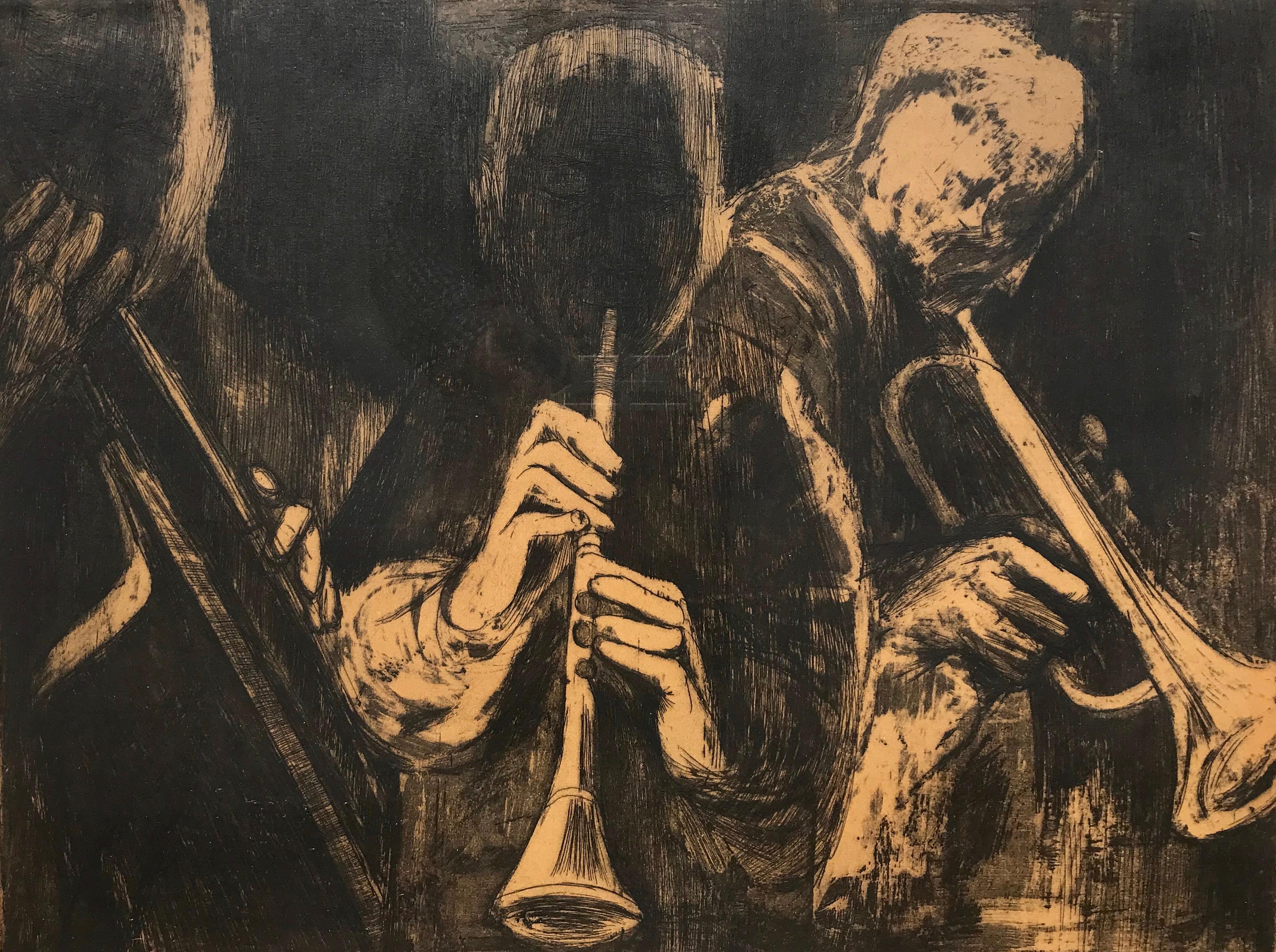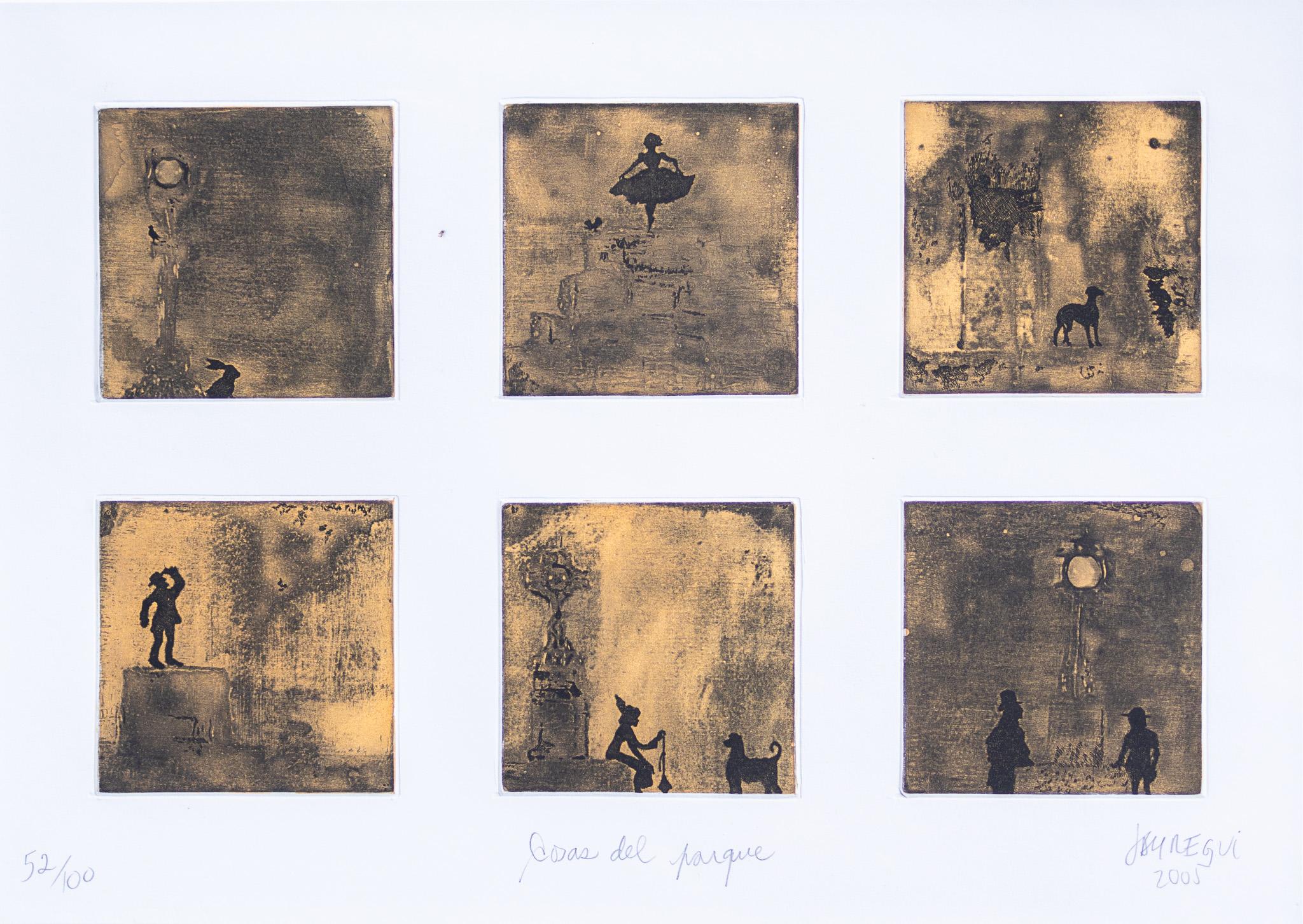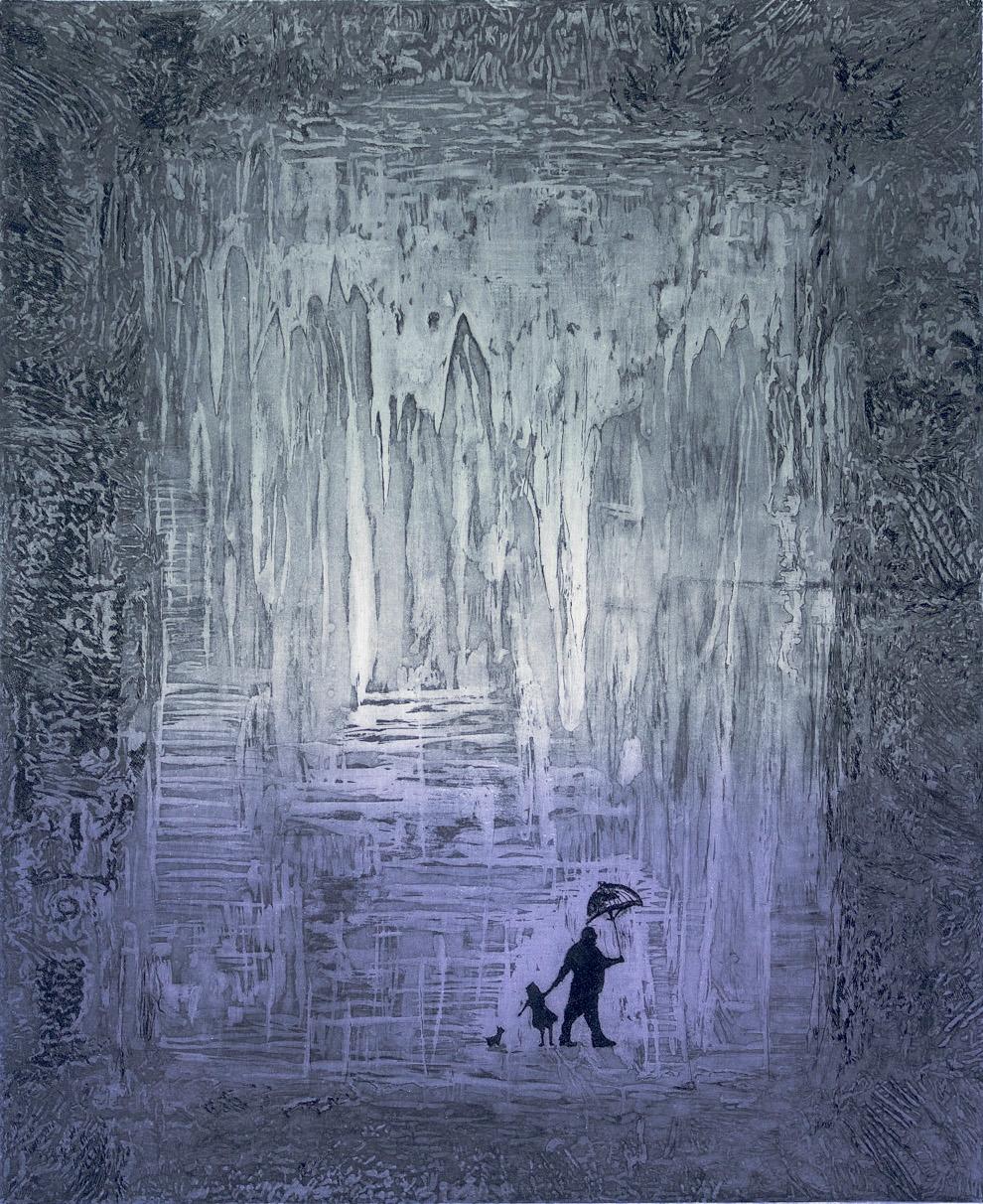Want more images or videos?
Request additional images or videos from the seller
“Untitled”Circa 1960
Circa 1960
About the Item
Original lithographic print done as a gravure using black ink attributed to the hand of the well known French artist, Jean Dufy. Signed in the plate “Dufy” lower right. Circa 1960. Condition is very good. “Pierre Hautot, Paris” label verso. Sheet size 15.25 by 12.5 inches. The artwork is housed in its original narrow gold leaf frame with silver inside edge. Overall framed measurements are 18.25 by 14.75 inches. Provenance: A Sarasota, Florida collector.
- Attributed to:Jean Dufy (1888 - 1964, French)
- Creation Year:Circa 1960
- Dimensions:Height: 11 in (27.94 cm)Width: 8.25 in (20.96 cm)Depth: 1 in (2.54 cm)
- Medium:
- Movement & Style:
- Period:
- Condition:Light toning of paper consistent with age. Light spotting of sheet in outer areas of sheet under mat.
- Gallery Location:Southampton, NY
- Reference Number:1stDibs: LU14113938322
About the Seller
5.0
Platinum Seller
These expertly vetted sellers are 1stDibs' most experienced sellers and are rated highest by our customers.
Established in 1977
1stDibs seller since 2013
471 sales on 1stDibs
Typical response time: 1 hour
- ShippingRetrieving quote...Ships From: Southampton, NY
- Return PolicyA return for this item may be initiated within 7 days of delivery.
More From This SellerView All
- “Trio”By Ruth LeafLocated in Southampton, NYArtist proof intaglio print of a trio of Jazz players by the American printmaker and author, Ruth Leaf. Signed, dated and titled in pencil. Condition: Very good. Provenance: Art-O-Rama, 1965. The artwork is matted and in its original thick mahogany frame with brass front edge. Overall framed 25 by 31.25 inches. Not examined out of frame. Ruth Leaf (1923 - 2015) Ruth Leaf was an American artist and a pioneer in the discipline of printmaking. While also fluent in the methods of linoleum, monotype, collagraph and collage, she is most known for her viscosity etchings...Category
1960s Post-Modern Figurative Prints
MaterialsArchival Paper, Intaglio
- “Adam and Eve”By Jack LevineLocated in Southampton, NYOriginal etching on archival paper by Jack Levine. Condition is very good; strong impression. Done in 1963. The etching is housed in a contemporary matte black frame. Under glass. Overall framed measurements are 24.5 by 17.25 inches. Provenance: A Sarasota, Florida estate. Publication Printed by Emiliano Sorini; published by Associated American Artists Full sheet; not trimmed. 22 by 15 inches Edition 74/100 in pencil lower left margin. Pencil signed by artist lower right margin Jack Levine American, 1915–2010 A painter and printmaker best known for political and social commentaries, Jack Levine drew inspiration from satirical German expressionist artists, such as George Grosz and Oskar Kokoscha, and took stylistic cues from the paintings of Titian, Diego Velázquez, and Francisco de Goya. Rejecting the formal qualities and ideologies of contemporary art movements, Levine caricatured 20th-century issues—inequality, big business...Category
1960s Post-Modern Figurative Prints
MaterialsArchival Paper, Etching
- “Le Repos du Sculpteur, 3”By (after) Pablo PicassoLocated in Southampton, NYDescription: Pablo Picasso created the Suite Vollard between 1930 and 1939 in honor of his friend and art dealer, Ambroise Vollard. The suite is comprised of 100 etchings, illustrat...Category
1990s Modern Figurative Prints
MaterialsArchival Paper, Lithograph
- “Minotaure Caressant une Femme”By (after) Pablo PicassoLocated in Southampton, NYDescription: Pablo Picasso created the Suite Vollard between 1930 and 1939 in honor of his friend and art dealer, Ambroise Vollard. The suite is comprised of 100 etchings, illustrat...Category
1990s Modern Figurative Prints
MaterialsLithograph, Archival Paper
- “Modele et Sculpeur avec sa Sculpure”By (after) Pablo PicassoLocated in Southampton, NYDescription: Pablo Picasso created the Suite Vollard between 1930 and 1939 in honor of his friend and art dealer, Ambroise Vollard. The suite is comprised of 100 etchings, illustrat...Category
1990s Modern Figurative Prints
MaterialsLithograph, Archival Paper
- “Judith”By Benton Murdoch SpruanceLocated in Southampton, NYStrong and vibrant color lithograph by the American artist, Benton Murdoch Spruance. Edition size in pencil lower left margin 7/40. Titled in pencil middle margin and signed in penc...Category
1950s Modern Figurative Prints
MaterialsArchival Paper, Lithograph
You May Also Like
- "Cosas Del Parque" Edition 52/100By Paul JaureguiLocated in Austin, TXThis piece is an etching which features 6 scenes from a park. Each square measures 3.75 x 3.75 inches.Category
Late 20th Century Post-Modern Prints and Multiples
MaterialsArchival Paper, Etching
- "La Vida Sigue" (Life Goes On), Edition 52/100By Paul JaureguiLocated in Austin, TXThis piece entitled "La Vide Sigue," which translate to "Life Goes On" depicts the silhouette of a child running and rolling a hoop while one rabbit run away and another watches. The...Category
Late 20th Century Post-Modern Figurative Prints
MaterialsArchival Paper, Etching
- "Llueve, Llueve" (Rain, Rain)By Paul JaureguiLocated in Austin, TXThis figurative piece by Paul Jauregui is a hand colored etching depicting the silhouette of a father, his daughter and her small dog all walking in the rain. The father holds an umb...Category
Late 20th Century Post-Modern Prints and Multiples
MaterialsArchival Paper, Etching
- The boy 1/17. 1983. Paper, lithography, 39x51 cmLocated in Riga, LVThe boy 1/17. 1983. Paper, lithography, 39x51 cm The artwork was published in the catalog - "Baņuta Ancāne. Personālizstāde ''Rīgas galerijā''. 30.09.-11.10.2003" Publisher: Neputn...Category
1980s Post-Modern Portrait Prints
MaterialsLithograph, Paper
- The Talmudists Post Soviet Non Conformist Avant Garde Judaica LithographBy Alek RapoportLocated in Surfside, FLDimensions w/Frame: 18.5 X 14.5 Alek Rapoport (November 24, 1933, Kharkiv, Ukraine SSR – February 4, 1997, San Francisco) was a Russian Nonconformist artist, art theorist and teacher. Alek Rapoport spent his childhood in Kiev (Ukraine SSR). During Stalin's "purges" both his parents were arrested. His father was shot and his mother spent ten years in a Siberian labor camp. Rapoport lived with his aunt. At the beginning of World War II, he was evacuated to the city of Ufa (the Bashkir Autonomous Soviet Socialist Republic). A time of extreme loneliness, cold, hunger and deprivation, this period also marked the beginning of Rapoport's drawing studies. After the war, Rapoport lived in Chernovtsy (Western Ukraine), a city with a certain European flair. At the local House of Folk Arts, he found his first art teacher, E.Sagaidachny (1886–1961), a former member of the nonconformist artist groups Union of the Youth (Soyuz Molodyozhi) and Donkey's Tail, popular during the 1910s–1920s. His other art teacher was I. Beklemisheva (1903–1988). Impressed by Rapoport's talent, she later (1950) organized his move to Leningrad, where he entered the famous V.Serov School of Art (the former School of the Imperial Society for the Promotion of Arts, OPKh, later the Tavricheskaya Art School). His association with this school lasted eight years, first as a student, and then, from 1965 to 1968, as a teacher. With "Socialist realism" the only official style during this time, most of the art school's faculty had to conceal any prior involvement in non-conformist art movements. Ya.K.Shablovsky, V.M.Sudakov, A.A.Gromov introduced their students to Constructivism only through clandestine means. (1959–1963) Rapoport studied stage design at the Leningrad Institute of Theater, Music and Cinema under the supervision of the famous artist and stage director N.P.Akimov. Akimov taught a unique course based on theories of Russian Suprematism and Constructivism, while encouraging his graduate students to apply their knowledge to every field of art design. Despite differences in personal artistic taste with Akimov, who was drawn to Vermeer and Dalí, Rapoport was influenced by Akimov's personality and liberalism, as well as the logical style of his art. In 1963, Rapoport graduated from the institute. His highly acclaimed MFA work involved the stage and costume design for I.Babel's play Sunset. In preparation, he traveled to the southwest regions of the Soviet Union, where he accumulated many objects of Judaic iconography from former ghettos, disappearing synagogues and old cemeteries. He wandered Odessa in search of Babel's characters and the atmosphere of his books. He organized a new liberal course in technical aesthetics, introducing his students to Lotman's theory of semiotics, the Modulor of Le Corbusier, the Bauhaus school, Russian Constructivism, Russian icons and contemporary Western art. As a result of his "radicalism," Rapoport was fired for "ideological conspiracy." He sought to cultivate himself as Jewish artist. This became particularly noticeable after the Six-Day War, when the Israeli victory led intellectuals, including the Jewish intelligentsia, to feel a heightened interest in Jewish culture and its Biblical roots. Rapoport's works of this period include Three Figures, a series of images of Talmudic Scholars, and works dealing with anti-Semitism. In the 1970s Rapoport joined the non-conformist movement, which opposed the dogmas of "Socialist realism" in art, along with Soviet censorship. The movement sought to preserve the traditions of Russian iconography...Category
1970s Post-Modern Figurative Prints
MaterialsLithograph
- The Rabbi 1977 Soviet Non Conformist Avant Garde PrintBy Alek RapoportLocated in Surfside, FLDimensions w/Frame: 25 3/4" x 20 3/4" Alek Rapoport (November 24, 1933, Kharkiv, Ukraine SSR – February 4, 1997, San Francisco) was a Russian Nonconformist artist, art theorist and teacher. Alek Rapoport spent his childhood in Kiev (Ukraine SSR). During Stalin's "purges" both his parents were arrested. His father was shot and his mother spent ten years in a Siberian labor camp. Rapoport lived with his aunt. At the beginning of World War II, he was evacuated to the city of Ufa (the Bashkir Autonomous Soviet Socialist Republic). A time of extreme loneliness, cold, hunger and deprivation, this period also marked the beginning of Rapoport's drawing studies. After the war, Rapoport lived in Chernovtsy (Western Ukraine), a city with a certain European flair. At the local House of Folk Arts, he found his first art teacher, E.Sagaidachny (1886–1961), a former member of the nonconformist artist groups Union of the Youth (Soyuz Molodyozhi) and Donkey's Tail, popular during the 1910s–1920s. His other art teacher was I. Beklemisheva (1903–1988). Impressed by Rapoport's talent, she later (1950) organized his move to Leningrad, where he entered the famous V.Serov School of Art (the former School of the Imperial Society for the Promotion of Arts, OPKh, later the Tavricheskaya Art School). His association with this school lasted eight years, first as a student, and then, from 1965 to 1968, as a teacher. With "Socialist realism" the only official style during this time, most of the art school's faculty had to conceal any prior involvement in non-conformist art movements. Ya.K.Shablovsky, V.M.Sudakov, A.A.Gromov introduced their students to Constructivism only through clandestine means. (1959–1963) Rapoport studied stage design at the Leningrad Institute of Theater, Music and Cinema under the supervision of the famous artist and stage director N.P.Akimov. Akimov taught a unique course based on theories of Russian Suprematism and Constructivism, while encouraging his graduate students to apply their knowledge to every field of art design. Despite differences in personal artistic taste with Akimov, who was drawn to Vermeer and Dalí, Rapoport was influenced by Akimov's personality and liberalism, as well as the logical style of his art. In 1963, Rapoport graduated from the institute. His highly acclaimed MFA work involved the stage and costume design for I.Babel's play Sunset. In preparation, he traveled to the southwest regions of the Soviet Union, where he accumulated many objects of Judaic iconography from former ghettos, disappearing synagogues and old cemeteries. He wandered Odessa in search of Babel's characters and the atmosphere of his books. He organized a new liberal course in technical aesthetics, introducing his students to Lotman's theory of semiotics, the Modulor of Le Corbusier, the Bauhaus school, Russian Constructivism, Russian icons and contemporary Western art. As a result of his "radicalism," Rapoport was fired for "ideological conspiracy." He sought to cultivate himself as Jewish artist. This became particularly noticeable after the Six-Day War, when the Israeli victory led intellectuals, including the Jewish intelligentsia, to feel a heightened interest in Jewish culture and its Biblical roots. Rapoport's works of this period include Three Figures, a series of images of Talmudic Scholars, and works dealing with anti-Semitism. In the 1970s Rapoport joined the non-conformist movement, which opposed the dogmas of "Socialist realism" in art, along with Soviet censorship. The movement sought to preserve the traditions of Russian iconography and the Constructivist/Suprematist style of the 1910s. Despite the authorities' persecutions of nonconformist artists (including arrests, forced evictions, terminations of employment, and various forms of routine hassling), they united in a group, "TEV – Fellowship of Experimental Exhibitions." TEV's exhibitions proved tremendously successful. In the same period, Rapoport became one of the initiators of another anti-establishment group, ALEF (Union of Leningrad's Jewish Artists). In the United States this group was known as "Twelve from the Soviet Underground." Rapoport's involvement with this group increased tension with the authorities and attracted KGB scrutiny, including "friendly conversations," surveillance, detentions and house arrests. It became increasingly dangerous for him to live and work in the USSR. In October 1976, Rapoport with his wife and son were forced to leave Russia. In Italy, Rapoport exhibited at the Venice Biennale, "La Nuova Arte Sovietica-Una prospettiva non-ufficiale" (1977), participated in television programs about nonconformist art in the Soviet Union, and created lithographic works continuing his theme of Jewish characters from Babel's play Sunset. In 1977, Rapoport's family was granted U.S. immigration status and settled in San Francisco. a significant event in Rapoport's life occurred in his meeting with San Francisco gallery owner Michael Dunev, who became his friend and representative, organizing all his exhibitions until the artist's death. Toward the end of the 1980s and beginning of the 1990s, Rapoport completed his most ambitious works on the theme of the Old Testament prophets: Samson Destroying the House of the Philistines (1989), Lamentation and Mourning and Woe (1990), the four paintings Angel and Prophets (1990–1991) and Three Deeds of Moses (1992). In 1992, the artist's friends in St. Petersburg organized the first exhibition of his works there since his departure into exile, with works patiently gathered from collectors and art museums. This exhibition, held in the City Museum of St. Petersburg and accompanied by headlines such as "A St. Petersburg artist returns to his town," was followed by much larger ones in 1993 (St. Petersburg and Moscow), organized in collaboration with Michael Dunev Gallery under the name California Branches – Russian Roots. He Exhibited in "Soviet Artists, Jewish Themes...Category
1970s Post-Modern Figurative Prints
MaterialsLithograph





